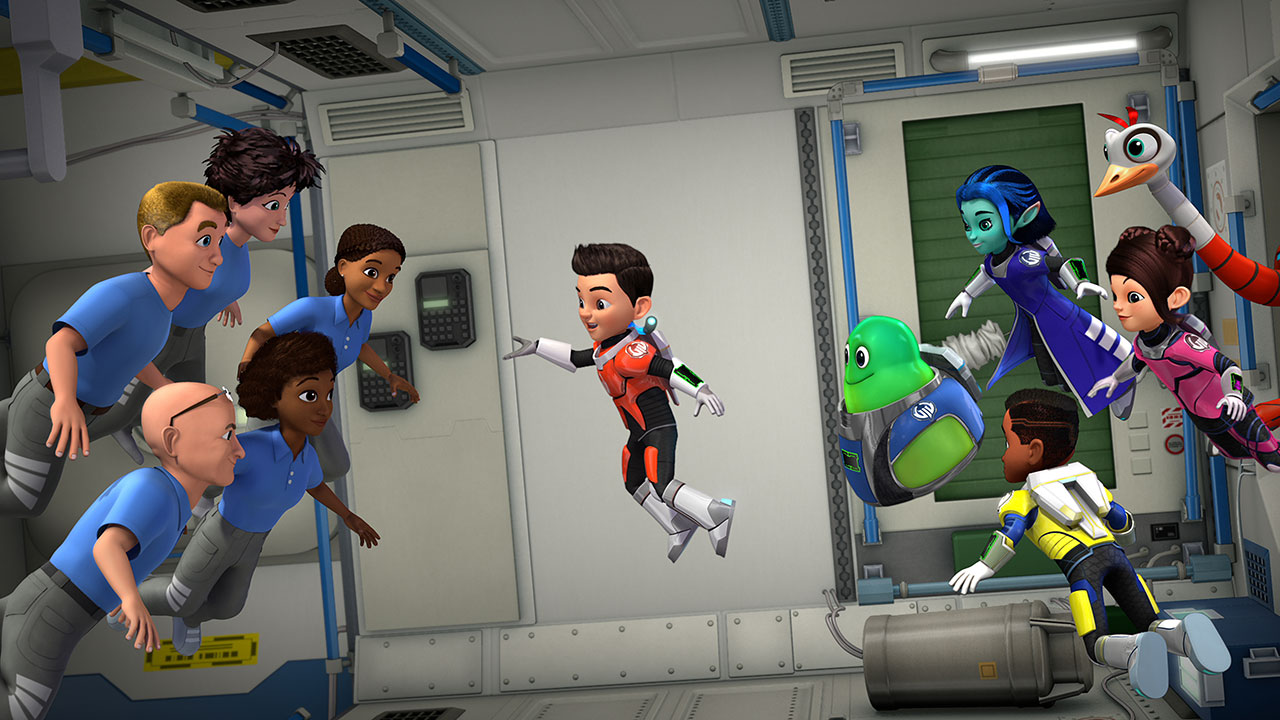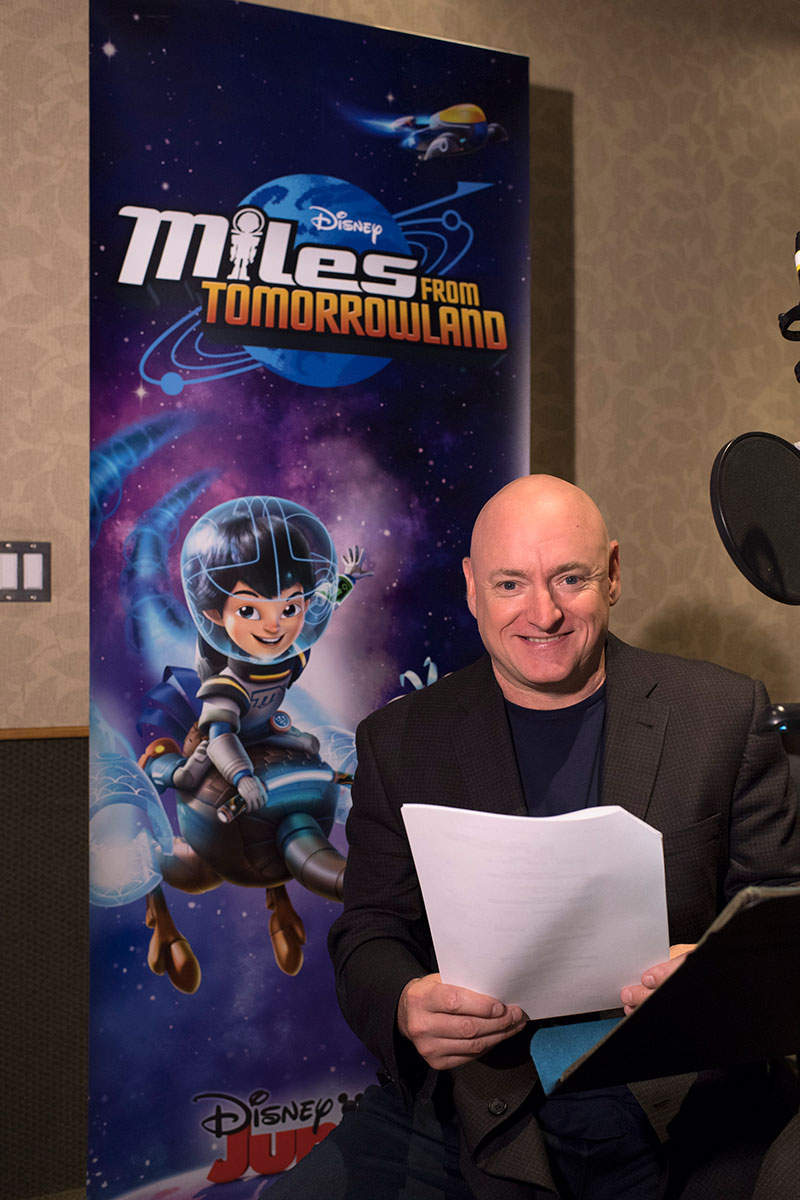Disney Junior 'Mission Force One' Debuts Space Station Episode in Orbit
Astronauts from today meet Miles from Tomorrowland in the next episode of Disney Junior's "Mission Force One."
The animated TV series, which follows the future space adventures of young Miles Callisto and his team of science, technology and art-skilled friends, looks "back" at our present day space program in "The Space Station Situation," the next episode of the series' third season.
The episode, which features the voices and likenesses of real space explorers, will debut for everyone watching here on Earth on Monday (May 7), about two weeks after it was seen by the six people currently living off the planet. [Astronauts Just Watched 'Star Wars: The Last Jedi' in Space!]
"I had heard the ISS [International Space Station] crew had watched the Ridley Scott movie 'The Martian' when it came out and thought that was so cool to have something current being watched in outer space," said "Mission Force One" creator and executive producer Sascha Paladino. "We had been doing so many events with NASA and looking for ways to bring our show beyond the television screen, so it seemed like it would be a really interesting possibility for us."
"I thought, 'How hard could it be?'" Paladino recalled. "Well, it is really hard to get something shown on the space station. There are a lot of hurdles and approvals that have to happen at NASA, but it seemed to be worth trying and fortunately Disney was really supportive of the idea."
Last week, the half hour episode became the first kids' television show to premiere on board the International Space Station. The setting was appropriate because the orbiting outpost is central to its episode's story.
Messing up vs. messing it up
"This was the first time we've ever had to get the look of something right, because usually we are inventing spaceships — we're creating our own crazy vehicles and inventions and gadgets and there are no rules, we are just using our imagination," explained Paladino. "We're often inspired by real technology or futuristic tech that we've seen plans for, but here it was a different challenge for us."
Get the Space.com Newsletter
Breaking space news, the latest updates on rocket launches, skywatching events and more!
The episode follows as Miles, his sister Loretta and their friends Mirandos, Blodger and Haruna as they travel back in time to prevent the space station from getting stuck in the future. The show's animators looked at NASA photography to get the details of the space station correct.
"This was our one chance over the course of the whole series to show an existing spacecraft, so it was really important to us to get it right," described Paladino. "We felt this tremendous responsibility. NASA agreed to let us do this and we wanted to show the ISS as it really is in its best light."
"It wasn't hard to find images because NASA is so great at sharing its photos," he added. "But there were so many iterations — over the years the ISS has changed and been added to until it reached its present state. We tried to make sure we had the most current version of the ISS."
A helpful tip came from one of the episode's voice talent, former NASA astronaut Scott Kelly, who visited the show's animation studio and previewed the artwork for the space station.
"He did have one comment we took to heart and that was it was too neat. He said the ISS was much more messy. Our designs at the time were pretty clean in terms of the lines and look of it. He said there were a lot of cables everywhere," Paladino said.
"We didn't want to do anything that would show the ISS in a bad light, but we tried to mess it up a little bit," Paladino said. [The International Space Station: Inside and Out (Infographic)]

Crew members 'cartoonized'
Joining Kelly lending their voices and likenesses to "The Space Station Situation" were U.S. astronauts Jeanette Epps and Yvonne Cagle of NASA, Italian astronaut Samantha Cristoforetti with the European Space Agency and Russian cosmonaut Mikhail Kornienko of Roscosmos. Cristoforetti, Kelly and Kornienko lived together on the space station during Expedition 43 in 2015.
"Glad I could help... and be cartoonized," wrote Kelly on Twitter on Monday (April 30). Kelly and Kornienko spent a record 340 days on the space station during the outpost's first yearlong mission.
"Haha! I recognize my haircut," tweeted Cristoforetti, referring to her animated self and a trim she received from Expedition 43 commander Terry Virts while she was on orbit.
NASA flight director Holly Ridings and Jet Propulsion Laboratory (JPL) scientists and engineers Randii Wessen, Diana Trujillo, Bobak Ferdowsi and Kevin Hand are also featured in the episode.
"This is how I look IRL [in real life]," tweeted Ferdowsi, who was dubbed "Mohawk Guy" by the press due to his hair style during the landing of NASA's Mars Curiosity rover in 2016.
Kevin Hand, who is the deputy project scientist for NASA's mission to Europa, has previously advised the show on depicting the moon of Jupiter. Padadino wanted to include Hand and his colleagues in the new episode, but knew that it would not be usual for JPL personnel to be at the station's mission control in Houston, where he wanted to show them.
"I asked everyone why a few JPL people would be in Houston and they said, 'Well, we would only be there if we were presenting a new design, talking about a new concept that mission control would need to help with,'" recounted Paladino. "They suggested a concept of a helicopter being thought about for Mars, so we used that idea."

Space facts and storytelling
Bill Nye, the "Science Guy" and CEO of The Planetary Society, also has a cameo in "The Space Station Situation," reprising his role as the alien scientist "Professor Rubicon." In addition, the episode features the talents of Grammy Award-winning banjo player Bela Fleck, who covers "There's a Great Big Beautiful Tomorrow," the theme from Walt Disney's Carousel of Progress.
"Mission Force One" (or "Miles from Tomorrowland," as the first two seasons were titled) incorporates space and science facts in each of its storylines. Experts from NASA, JPL, the Space Tourism Society and Google serve as consultants, but the facts they offer are weighed against the needs of the story.
"NASA was not thrilled that we proposed breaking the ISS in this episode. I don't think it was their first choice of how we'd portray the ISS, but it was important that our story still had the excitement and drama that all our episodes have," Paladino said. "So it was finding that middle ground between making sure the space facts never felt didactic or like a lesson — it should be fun and entertaining — and using this opportunity to highlight the ISS and what an incredible achievement it is."
"The Space Station Situation" marks the first time that the show has animated real astronauts (or any real people) and only the second time that it has had a real-life space explorer voice a character. Apollo 11 moonwalker Buzz Aldrin recorded the part of "Commander Copernicus," head of the Tomorrowland Transit Authority, in a previous episode.
In addition to the premiere on the space station, a private screening of "The Space Station Situation" was held at Space Center Houston, the visitor center for NASA's Johnson Space Center in Texas, this past weekend. The half-hour episode makes its television debut at 5:30 p.m. EDT on Monday (May 7) on Disney Junior and in the DisneyNOW app.
See more images and watch video clips from Disney Junior's "Mission Force One" at collectSPACE.
Follow collectSPACE.com on Facebook and on Twitter at @collectSPACE. Copyright 2018 collectSPACE.com. All rights reserved.
Join our Space Forums to keep talking space on the latest missions, night sky and more! And if you have a news tip, correction or comment, let us know at: community@space.com.

Robert Pearlman is a space historian, journalist and the founder and editor of collectSPACE.com, a daily news publication and community devoted to space history with a particular focus on how and where space exploration intersects with pop culture. Pearlman is also a contributing writer for Space.com and co-author of "Space Stations: The Art, Science, and Reality of Working in Space” published by Smithsonian Books in 2018.In 2009, he was inducted into the U.S. Space Camp Hall of Fame in Huntsville, Alabama. In 2021, he was honored by the American Astronautical Society with the Ordway Award for Sustained Excellence in Spaceflight History. In 2023, the National Space Club Florida Committee recognized Pearlman with the Kolcum News and Communications Award for excellence in telling the space story along the Space Coast and throughout the world.











